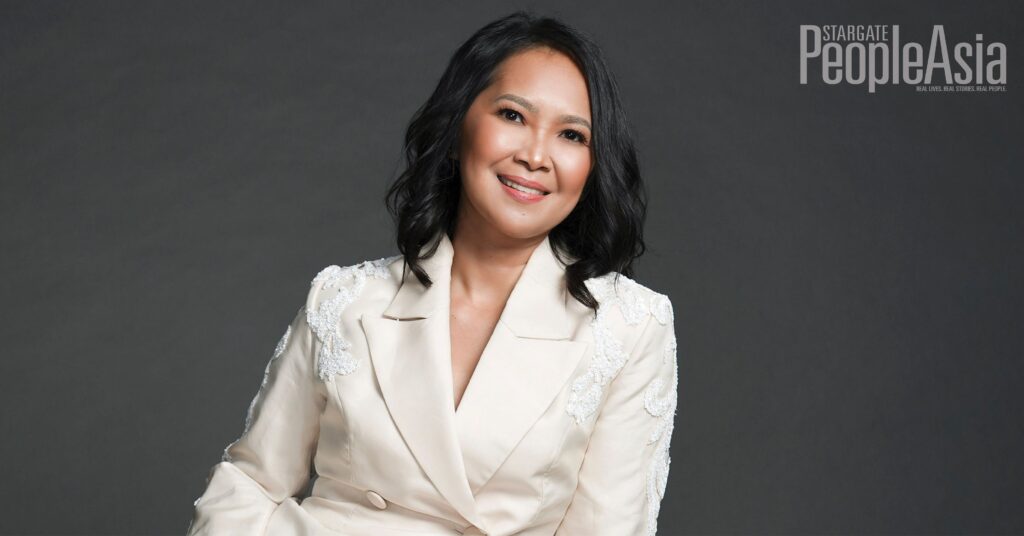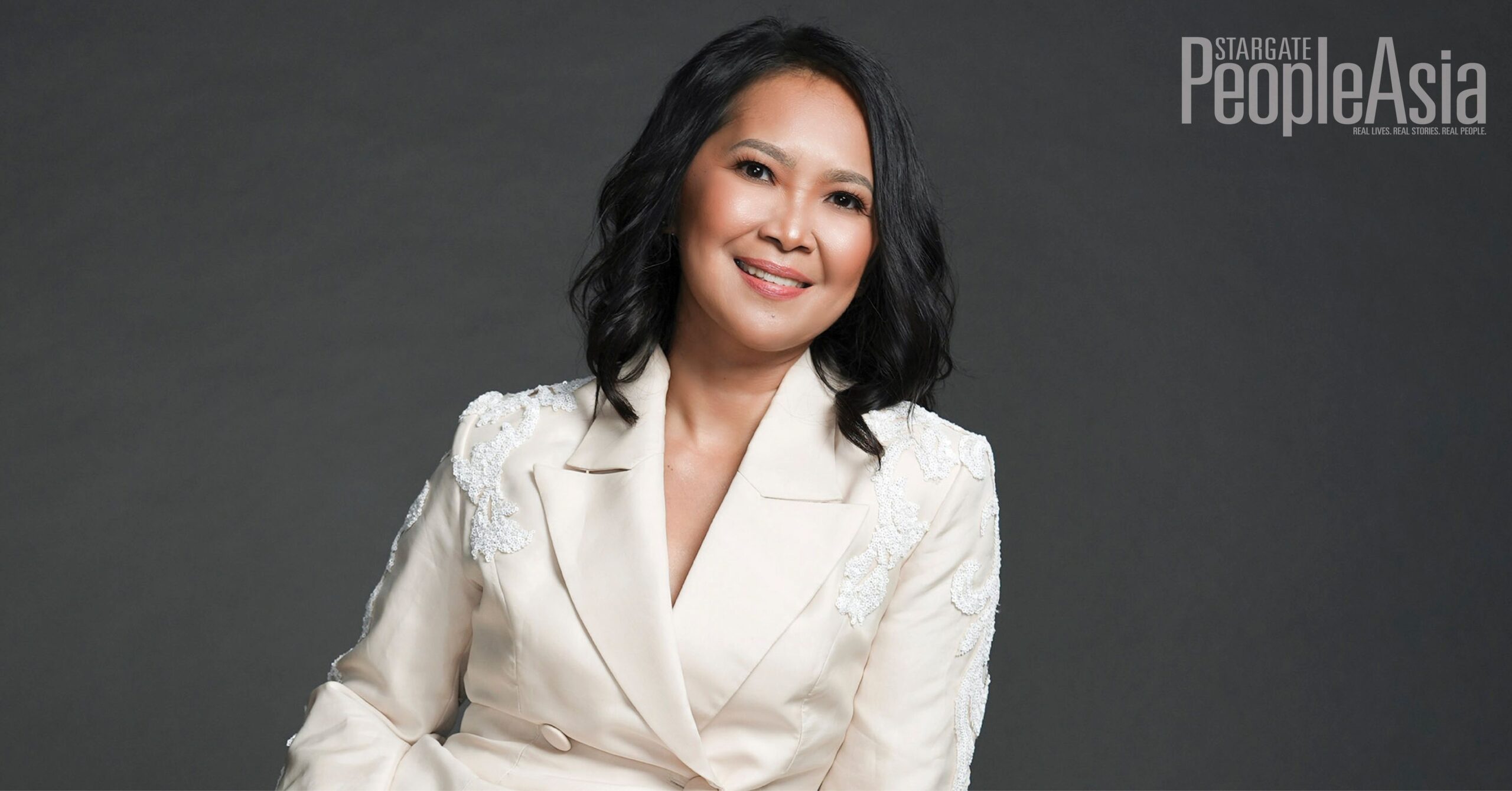As president and CEO of MediaQuest Holdings, she thrives under pressure, mainly from reading, anticipating developments and quickly adapting to a fickle public’s viewing preferences, which, in the digital age, can change at warp speed.
By Alex Y. Vergara
Photography by Mark Chester Ang
Snacking on, so to speak, as opposed to binge-watching, almost all forms of entertainment on the small screen — from Hollywood staples to Korean dramas, news and current affairs programs to sports coverages — comes with her job. Although it’s also one of her favorite ways to relax and de-stress during her me moments, watching content on television and other digital gadgets is also one of Jane Jimenez-Basas’ ways to keep tabs on the ever-shifting entertainment landscape. In other words, this lady seldom sits in front of a monitor without an agenda.
As president and CEO of MediaQuest Holdings as well as concurrent president and CEO of its two operating units — Cignal TV and Nation Broadcasting Corp. (NBC) — Jane thrives under pressure, mainly from reading, anticipating developments and quickly adapting to a fickle public’s viewing preferences, which, in the digital age, can change at almost warp speed. Keeping her ears close to the ground and her eyes peeled for any looming trends and developments in entertainment in the hopes of investing on the right talents and hit content also come with the territory.
What she does, which draws heavily from her years of experience, innate talent and plain gut feel in marketing, communication and strategic planning, is certainly a far cry from the training she initially received at the University of the Philippines–Diliman, where she graduated with a degree in Business Administration and Accountancy. Coming from a middle-class family composed of six children, Jane felt then that she was the one who had to take on the baton being passed on to them by her CPA parents.
“Even in school, my strengths were in marketing and communication, even much stronger compared to my accounting subjects,” she shares with PeopleAsia. So, in the end, her interest and affinity for marketing prevailed.
So, when the opportunity to launch the first GSM (Global System for Mobile) phone called Globe Handyphone came sometime in the late ’90s, Jane grabbed it by joining the company as an assistant marketing manager. Over the years, she moved companies while rising through the ranks. By 2022, Jane was already senior vice president of Smart Wireless before being appointed to her current position at MediaQuest and its holding companies.
Master strategist
As such, her primary responsibility is to drive strategic thinking and push for innovations within these organizations. “It’s very important that I’m able to assess the current state of business as well as opportunities for the future to be able to define a growth path, both short-term and long-term,” Jane adds.
Doing all these entails a broad understanding of consumer behavior, evolution in technology, changing partnerships in the ecosystem as well as keeping one’s finger on the pulse of pop culture. Only by fully understanding and making sense of these multiple pillars will Jane be able to define and plot what the next best steps to take are for the organizations she leads.
On a lighter note, this mother of four, whose children’s ages range from 11 to 21, finds herself regularly consulting them on matters that only members of today’s younger generation would totally understand.

“On top of my responsibilities, I still need to keep up with pop culture and what’s trending on social media. And by talking to my children, I get a lot of insights when they tell me what they’re watching or listening to. It really helps a lot to keep in touch with what young people today are into,” says Jane, who’s married to Deanno Basas, president and CEO of ATRAM Digital.
Her job seems easy enough on paper, but when you deal with such an area as entertainment, Jane says, “There’s no exact science. Sometimes you think you have a sure hit content in your hands, but when you finally launch it, it flops.”
Room for creativity
“What’s good about this industry,” she continues, “is it also offers room for creativity. And I’d like to believe that I’m also blessed with a creative mind. The stress and sometimes the chaos are always there, but they are balanced out by the fun aspects of the job.”
Although gut feel plays a big role in Jane’s decision-making, she also makes sure that her moves are based not entirely on instinct and past experiences, but also on sound input from her team. At the end of the day, she adds, you do take risks, but you can’t totally do it blindly, especially in a free-to-air business model like TV5 where a substantial cash investment is involved to be able to air hourly shows 24/7.
Cignal TV, on the other hand, is a subscription or satellite pay TV business, which operates direct to home (DTH) digital via those ubiquitous dishes increasingly seen these days outside houses and high-rise residential units.
Since MediaQuest is a holdings company, Jane’s responsibilities involve running both business models. They don’t involve, say, running the daily operations of TV5 or overseeing the infrastructure requirements of Cignal TV. Instead, her responsibilities are more strategic in nature.
“Examples are the shows and artists (on TV5) that you see, and our partnerships with the likes of TVJ Productions, which, by the way, is another MediaQuest subsidiary. Such strategic moves were primarily made by me and my team,” she explains.
After MediaQuest acquired majority ownership of TVJ Productions, Jane has also become its president. But she still reports to former Sen. Tito Sotto, who remains chairman of the said production outfit. Apart from owning TV5 and NBC, MediaQuest also has a majority stake at BusinessWorld and The Philippine STAR newspapers.
Owing largely to the technology behind Cignal TV, which is DTH digital, it has now become the country’s biggest subscription TV service. It has also eclipsed its sister company, TV5, by almost four-fold in terms of revenue. By itself, TV5 isn’t doing badly either.
“We are number two in the free-to-air space right now,” Jane adds. “But there’s really a lot of things that we need to do to make sure that we’re able to bring sustained growth for TV5.”
As for Cignal TV’s continued growth in terms of revenue and subscriber base, Jane attributes this positive development not only to the DTH technology it uses, but also to the country’s very geographic makeup itself, which is archipelagic. While cable TV, for instance, uses, well, cable, towers and posts to deliver content carried by a range of channels to its subscribers’ homes, Cignal relies primarily on wireless satellite to relay its products.

Perfect for an archipelago
“If we go back a bit further, you can compare Cignal TV’s success to mobile wireless. For the longest time, we were using wired landline phones, but when wireless technology was introduced and became accessible, we soon saw millions of customers with cellphones in their hands. I really believe in the power of wireless, especially for a country such as ours,” says Jane.
But isn’t Jane worried that digital streaming services offered by the likes of Netflix, HBO Plus and Amazon Prime will soon hamper Cignal TV’s growth, even encourage many of its subscribers to drop it altogether in favor of streaming? Well, that would depend on the availability and easy access to the Internet.
“For you to enjoy an uninterrupted streaming experience, you have to have a very reliable and strong Internet access,” says Jane. “Given the country’s demographics, from a cost standpoint, streaming might not be an automatic option for a good number of Filipinos.”
For sure, given that Internet penetration continues to expand in the Philippines, streaming will soon catch up with DTH. Jane’s observation is based on the simple reason that streaming also targets individuals whereas Cignal TV, by the very nature of its service, is limited to targeting homes.
“You only have 20 million homes versus 120 million Filipinos,” she concedes. “If you’re able to build a subscription business via OTT (over the top) streaming service, that would be great. And that’s why we are doing the same.”
In Jane’s book, ignoring consumer consumption behavior and looming tectonic shifts in technology, no matter how seemingly insignificant they are at first blush, is the worst thing a CEO can do. “What we need to do is to know what our core is and make sure that we leverage that core given prevailing and likely opportunities in the market,” she adds.
So, if an outsider who still doesn’t totally get it asks Jane what she does, her answer is simple: “My business is not the platform nor is it the distribution technology. My business is all about content creation and aggregation. The platforms that I use are just there to distribute the content.”
Whether these are digital proprietary platforms or platforms that are already readily available to the public like YouTube and Facebook, Jane makes sure that they’re able to build a digital strategy around these available resources. The company may or may not own such platforms.
Content aggregation, after all, is at the heart of what she and her team do.
Art direction by Dexter Francis de Vera
Makeup by Kenjie Nocillado for Estee Lauder
Hair by Xean Nucum for Estee Lauder
Styling by Mike de Guzman and George Palmiano of MGP, assisted by Ysabelle Bianca Viray





